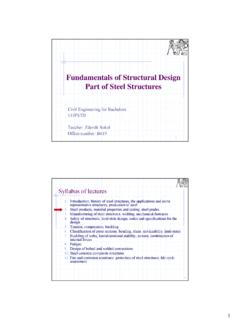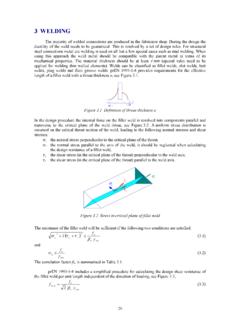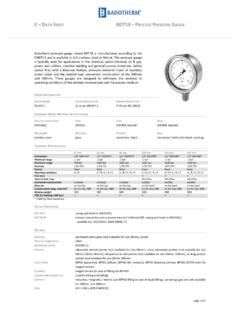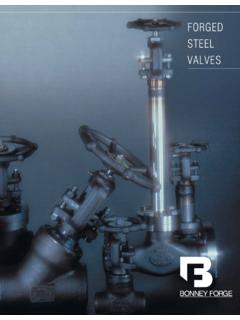Transcription of 12. TESTING OF CEMENT – PART 1. - cvut.cz
1 Chapter 12- TESTING of CEMENT part 1. 12. TESTING OF CEMENT part 1. Density The density is the fundamental physical characteristic of the material. Density is defined by mass of a unit volume of a material substance, expressed as kilograms per cubic metre. m =. Vh where is -3 -3. density in ( ). m mass of the material sample in kg (g). 3 3. Vh volume of the specimen in m (cm ). The mass can be determinate by scale (usually analytic balance), to determine volume of loose material is more difficult. For determination of CEMENT density the pycnometric method is used. Determination of Density by Pycnometric Method. Pycnometric method is indirect method; the measuring of volume is substituted by several weighing of material in pycnometer. Pycnometer is glass (or metal) bottle with a tight fitting stopper having a small hole in its centre. The hole in the stopper allows excess liquid to escape and the volume of the liquid in the pycnometer is always the same.
2 Density by pycnometry is calculate from basic formula: m k =. m + m4 m3. where m is mass of the sample of the tested material (m = m2 m1). m1 mass of dry empty pycnometer including stopper m2 mass of dry pycnometer with sample and stopper m3 mass of closed pycnometer with sample and measuring liquid m4 mass of the closed pycnometer with measuring liquid k density of measuring liquid at tested temperature Note: Measuring liquid could not be water in case of measuring CEMENT density! Usually is used alcohol. TESTING procedure weight mass of the empty pycnometer with stopper - m1. fill the pycnometer with measuring liquid. Replace stopper carefully, allowing excess liquid to escape through the hole in the stopper. Make sure there are no bubbles. Dry outside and weight . m4. fill the dry, empty pycnometer about 1/3 full of the sample. Closed it and weight again m2.
3 Page 59. Building Materials 10- TESTING Methods add measuring liquid to the sample. Fill pycnometer about 2/3 full. Mix up with caution and boil the pyknometer for 2 hours. After cooling refill with the liquid, closed the pycnometer and weight - m3. calculate the mass of the sample from formula: m = m2 - m1. count the density from the basic formula. Fig.:29 Derivation of the formula for density determined pycnometric method where mk is mass of liquid, volume of which was pushed up by volume of the solid material Fineness Standard EN 196-6 describes two methods of determining the fineness of CEMENT : sieving method air permeability method ( Blaine). Sieving Method This method serves only to demonstrate the presence of coarse CEMENT particles. This method is primarily suited to checking and controlling production process. The fineness of CEMENT is measured by sieving it on standard sieves.
4 The proportion of CEMENT of which the grain sizes are larger than the specified mesh size is thus determined. Air Permeability Method ( Blaine Method ). The fineness of CEMENT is measured as specific surface. Specific surface is expressed as the total surface area in square metres of all the CEMENT particles in one kilogram of CEMENT . The higher the specific surface is, the finer CEMENT will be. Principle of air permeability method is in observing the time taken for a fixed quantity of air to flow through compacted CEMENT bed of specified dimension and porosity. Under standardised conditions the specific surface of CEMENT is proportional to t where t is the time for given quantity of air to flow through the compacted CEMENT bed. The number and size range of individual pores in the specified bed are determined by the CEMENT particle size distribution which also determined the time for the specified air flow.
5 The method is comparative rather than absolute and therefore a reference sample of known specific surface is required for calibration of the apparatus. page 60. Chapter 12- TESTING of CEMENT part 1. A bed of CEMENT is prepared in special permeability cell and have exact porosity e = 0,500 weight a quantity of CEMENT . The weight of the CEMENT is calculated from m1 = 0,500 V [g]. where is the density of the CEMENT [ ]. -3. volume of the CEMENT bed [cm ]. 3. V. Specific surface S is expressed as S=. K.. e3. (1 e).. t [cm .g ]. 2 1. 0,1 . where K is the apparatus constant e porosity of the bed t the measured time [s]. density of CEMENT [ ]. -3. the viscosity of air at the test temperature taken from Tab.:27. The apparatus constant is determinate by measuring permeability of reference CEMENT of known specific surface. The procedure repeats three times for three samples of CEMENT bed.
6 For each sample is calculated constant K from formula: (1 e) 0,1 0. K = S0 0 . e3 t0. is the specific surface of the reference CEMENT [cm .g ]. 2 -1. where S0. 0 density of the reference CEMENT [ ]. -3. t0 measured time [s]. 0 air viscosity at the test temperature [ ]. With the specified porosity of e = 0,500. 0,1 0. K = 1,414 S0 0 . t0. The mean of three values of K is the constant K for the apparatus. page 61. Building Materials 10- TESTING Methods Fig.:30 Blaine apparatus CONICAL SOCKET. PERMEABILITY PLUNGER. STOPCOCK CELL. MANOMETER. ETCHED. LINES. COMPACTED. CEMENT BED. PERFORATED DISC. RUBBER BULB. TESTING procedure Place the perforated disc on the ledge at the bottom of the cell and place on it a new filter paper disc. Place the weighed quantity of CEMENT , m1, in the cell. Place a second new filter paper disc on the levelled CEMENT . Insert the plunger and press it gently but firmly until the lower face of the cap is in contact with the cell.
7 Slowly withdraw the plunger, rotate it through 90 and press once again. The bed is now compacted and ready for the permeability test. Test is performed on the Blaine apparatus (see Fig.:30). It is practically manometer in the U-tube form. One arm of the manometer is provided at the top with conical socket to form an airtight fit with the conical surface of the cell. The same arm has four etched lines M1 to M4 and T-joint, which lead to an airtight stopcock beyond which is attached aspiration rubber bulb. Manometer is filled to the level of the lowest etched line with non-volatile, non-hygroscopic liquid of low viscosity and density (such as dibutylphthalate or light mineral oil). Insert the conical surface of the cell into the socket at the top of the manometer. Open the stopcock and with gentle aspiration raise the level of the manometer liquid to that of the highest etched line.
8 Close the stopcock and the manometer liquid will begins to flow. Start the timer as the liquid reaches the second etched line and stop it when the liquid reaches the third etched line. Record the time, t, and the temperature, T. The procedure repeats three times Calculate three values of the specific surface and the mean of them. page 62. Chapter 12- TESTING of CEMENT part 1. Tab.:27 Viscosity of air and 0,1 . Temperature [ C] Air viscosity [ ] 0,1 . 16 17 18 19 20 21 22 23 24 linear interpolation can be used for the determination of the intermediate values Determination of Setting Time The setting time is determined by observing the penetration of needle into CEMENT paste of standard consistence until it reaches a specified value. The laboratory shall be maintained at a temperature of 20 2 C and a relative humidity of not less than 65 %. Standard Consistence Test CEMENT paste of standard consistence has a specified resistance to penetration by a standard plunger.
9 The water required for such a paste is determined by trial penetrations of pastes with different water contents. Content of water is expressed as percentage by mass of the CEMENT . Vicat apparatus (see Fig.:31) with the plunger is used for the test. The plunger shall be of non- corrodible metal in the form of a right cylinder of 50 1mm effective length and of 10,00 0,05 mm diameter. The total mass of moving parts shall be 300 1 g. part of the Vicat apparatus is the mould from hard rubber (of truncated conical form) on the glass base-plate. Procedure calibrate the Vicat apparatus by lowering the plunger to rest on the base-plate to be used and adjusting the pointer to read zero on the scale. Raise the plunger to the stand-by position. weight 500 g of CEMENT (to the nearest 1g). Weight a quantity of water (distilled or deionized), 125 g, in the mixer bowl or measure the water from the graduated cylinder into the mixer bowl.
10 Ad the CEMENT carefully to the water in order to avoid loss of water or CEMENT . The time of addition shall be not less than 5 s nor more than 10 s. Note the time of completion of the addition as zero time, from which later measurements of time shall be made. start the mixer immediately and run at low speed. stop the machine after 90 s for 15 s during which remove with a suitable scraper any paste adhering to the bowl outside the mixing zone and return it to the mix. Restart the machine and run at low speed for further 90 s. The total mixer running time shall be 3 min. page 63. Building Materials 10- TESTING Methods transfer the paste immediately to the mould and fill it to excess. Remove the excess gently and make a smooth upper surface immediately after levelling the paste, transfer the mould and base-plate to the Vicat apparatus and position it centrally under the plunger.







